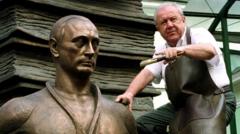Georgian-Russian artist Zurab Tsereteli, famed for his monumental sculptures that often sparked debate, has died at the age of 91. Born in Tbilisi, Tsereteli's notable contributions included iconic structures such as the controversial 98-meter (321-foot) monument to Tsar Peter the Great in Moscow—the same figure who was known to have disdained the city he founded.
Ascending to fame during the Soviet era, Tsereteli was instrumental in shaping the artistic landscape for the 1980 Olympic Games in Moscow and was involved in numerous international projects. His political connections were profound; he notably expressed admiration for Russian President Vladimir Putin, attributing inspiration for his art to the president's character.
In a statement following Tsereteli’s passing, Maria Zakharova, a spokesperson for the Russian Foreign Ministry, hailed him as a significant figure in fostering creativity and peace. She asserted that his artistic spirit would endure through his creations.
Despite often polarizing opinions about his work—particularly over the towering Peter the Great monument, which irked many residents—Tsereteli retained considerable respect within the art community. He served as the president of the Russian Academy of Arts and had interactions with notable artists, including a famed meeting with Picasso in Paris.
His extensive portfolio includes significant landmarks, such as the Columbus Monument in Spain, the Chronicle of Georgia in Tbilisi, and the Tear of Grief in New Jersey, which honors 9/11 victims. Tsereteli’s artistic endeavors extended to political commentary as well, exemplified by his sculpture "Good Defeats Evil" at the UN Headquarters, which symbolizes the triumph over nuclear war through diplomatic efforts.
Controversy often surrounded Tsereteli’s larger works, such as a massive statue of Pope John Paul II erected in France, which faced backlash for breaching secularism laws. One of his most monumental achievements is the Birth of the New World in Puerto Rico, standing tall at 110 meters (360 feet) after facing rejection from multiple U.S. cities.
In addition to sculpture, Tsereteli was also known for his floral paintings and played a vital role in restoring Moscow’s Cathedral of Christ the Saviour, further solidifying his status as a multifaceted artist.



















